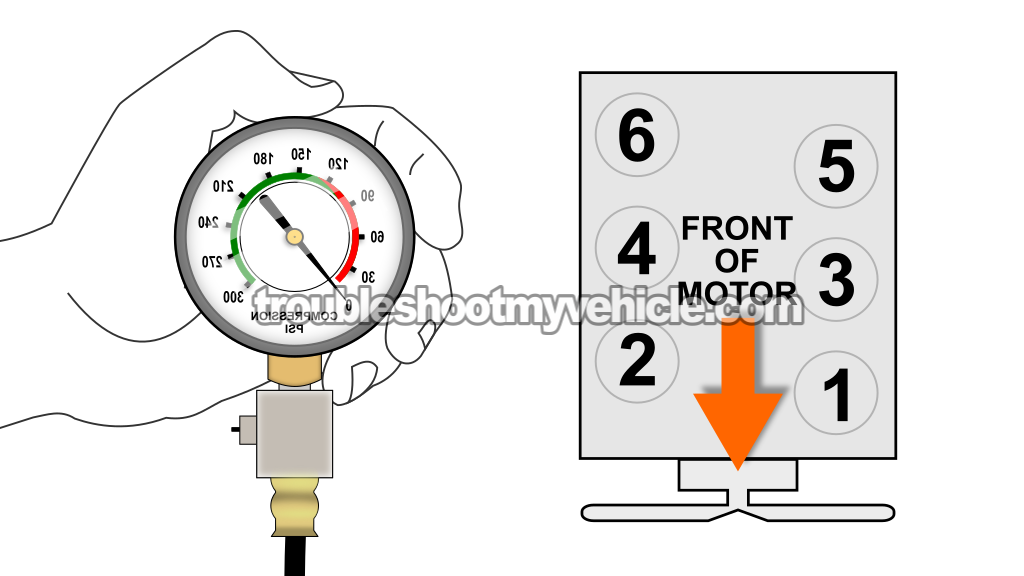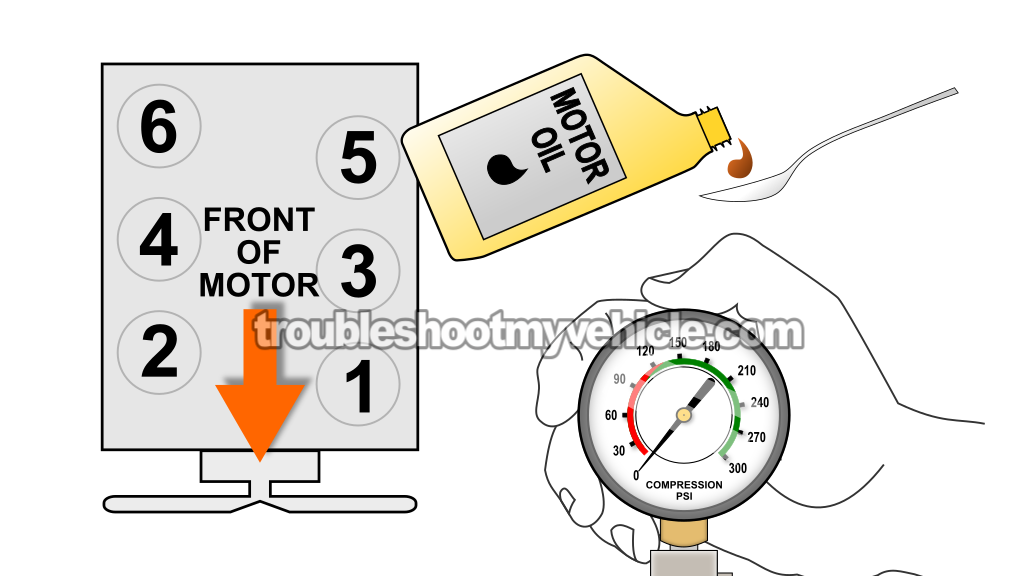
If your engine has an engine compression problem, you'll usually see one of two things: The engine might not start at all or it'll start but run rough and misfire.
Checking engine compression isn't difficult. In this tutorial, I'll show you how to run the test and make sense of the results. You'll easily figure out if a compression problem causing your engine's no-start or performance issue.
Contents of this tutorial:
APPLIES TO: This tutorial applies to the following vehicles:
- 3.9L V6 Dodge Ram B150 Van: 1989, 1990, 1991, 1992, 1993, 1994.
- 3.9L V6 Dodge Ram B250 Van: 1989, 1990, 1991, 1992, 1993, 1994.
- 3.9L V6 Dodge Ram B1500 Van: 1995, 1996, 1997, 1998, 1999, 2000, 2001, 2002, 2003.
- 3.9L V6 Dodge Ram B2500 Van: 1995, 1996, 1997, 1998, 1999, 2000, 2001, 2002, 2003.
Symptoms Of Engine Compression Problems
Engine compression problems usually lead to one of two things.
- Engine won't start: The engine cranks, but refuses to start.
- Performance problems: The engine starts but runs with a misfire.
If the engine does start, you might notice a few of these:
- Rough idle: The engine runs rough but doesn't throw a misfire code.
- Misfire codes: The PCM (on OBD II cars) logs these:
- P0300: Random misfires.
- P0301: Misfire In Cylinder 1.
- P0302: Misfire In Cylinder 2.
- P0303: Misfire In Cylinder 3.
- P0304: Misfire In Cylinder 4.
- P0305: Misfire In Cylinder 5.
- P0306: Misfire In Cylinder 6.
- Misfires during acceleration: You'll feel it when you hit the gas.
- Idle misfires: Engine only misfires while idling, but smooths out when you rev it.
- Bad gas mileage: You're filling up way more often than usual.
- Strong exhaust smell: You'll smell a heavier exhaust coming out from the tailpipe while the engine is running.
Important Tips And Suggestions
TIP 1: If the engine's been running for any length of time, wait until it cools off all the way before pulling the spark plugs.
Removing the spark plugs from a hot engine can strip the threads in the spark plug holes —and believe you me, that's a headache you really don't want.
TIP 2: When unplugging the spark plug wires from the spark plugs, use a spark plug wire puller.
This tool makes it way easier to unplug the wires —and more importantly, it helps prevent the metal terminal (the part that connects to the spark plug) from detaching and getting stuck on the plug when you pull the wire off.
If you don't have one, you can check it out and buy it here: OEMTOOLS 25542 Spark Plug Pliers. (at: amazon.com).
Which Compression Tester Should I Buy?
The following engine compression tester kits all come with a storage case and more importantly, don't cost and arm and a leg:
Disclosure: As an Amazon Associate, I earn from qualifying purchases. If my tutorials help you, using these links is an easy way to support the site at no extra cost to you. Thank you!
TEST 1: Dry Compression Test

To get the most accurate picture of your van engine's health (whether it won't start or it has a rough idle or misfire) you'll want to test the compression of all six cylinders.
The instructions below assume you're testing all six cylinders, but you don't have to. That said, even if you know there's just one dead cylinder, try to test at least two others as well.
This way, you can compare the compression readings from the "dead" one to the two "good" ones and see if the compression is within an acceptable range.
No compression tester? No problem. You can swing by your local auto parts store —most of them let you rent or buy one. Wanna save some cash? You can check out my recommendations here: Which Compression Tester Should I Buy?
Alright, let's get started:
- 1
Disconnect the spark plug wires from the spark plugs.
IMPORTANT: Label each spark plug wire with the cylinder number they belong to. You want to avoid losing the spark plug wires' firing order. - 2
Remove the spark plugs.
Be extra careful not to drop any. If the porcelain cracks, you'll be dealing with a misfire later —and that's a pain in the neck you want to avoid. - 3
Install the compression gauge into cylinder #1's spark plug hole.
NOTE: Just hand-tighten it. Don't use any tools to tighten it down. - 4
Have someone crank the engine until the needle on the gauge stops moving up.
- 5
Write down the pressure reading and note which cylinder it came from.
- 6
Repeat steps 3 trough 6 on the rest of the cylinders.
Now let's break down what your results mean:
CASE 1: All six cylinders show 0 PSI. That tells you something's seriously wrong inside your 3.9L V6 engine. Usually it's one of these:
- The timing chain snapped.
- The engine threw a rod.
Even if you get a reading under 100 PSI (but not zero), that still points to internal engine trouble.
CASE 2: All cylinders have compression, but the numbers are all over the place. It's normal for them to be a little different. But if the difference is too big, you're gonna get rough idling or misfires.
To figure out what those numbers are telling you, head over to: Interpreting Your Compression Test Results.
Interpreting Your Compression Test Results
It's totally normal for compression numbers to be a bit different, especially if the 3.9L V6 engine in your Dodge Ram van has racked up some serious miles.
Most of the time, the differences are small and don't cause any trouble. But if one or more cylinders drop more than 15% below the highest reading, you're gonna be dealing with a misfire or rough idle issue.
Figuring out if a cylinder's "dead" because of low compression is super simple —you just need to do a little math.
You've got two options for this 15% check: grab a pen and paper and do the math yourself, or save time by using my low compression calculator. You can find it here:
- Online Low Engine Compression Calculator (at: easyautodiagnostics.com).
If you want to do it by hand, here's how to break it down:
- STEP 1: Take the highest reading and multiply it by 0.15 (that's 15%).
- STEP 2: Round that number to the nearest whole number. (Like, 25.6 becomes 26).
- STEP 3: Subtract that rounded number from your highest compression reading.
- ANSWER: That final number is the lowest pressure any cylinder should have. If one falls below it, that cylinder has a compression problem.
Now, let me give you a more specific example: Let's say that I got the following compression readings:
| Cylinder | Pressure |
|---|---|
| #1 | 165 PSI |
| #2 | 95 PSI |
| #3 | 155 PSI |
| #4 | 175 PSI |
| #5 | 160 PSI |
| #6 | 175 PSI |
My next step is to do the following calculation:
- STEP 1: 175 x 0.15 = 26.25.
- STEP 2: 26.25 = 26 (rounded to nearest one).
- STEP 3: 175 - 26 = 149.
- ANSWER: 149 PSI. Any cylinder with this compression (or lower) value will misfire.
Since cylinder #2 only showed 95 PSI, that tells me it's "dead" and the reason for the misfire.
To see if your lowest reading's still in the safe zone, you'll need to run that same 15% calculation. Just make sure you're using the highest number from your own test, not the one from this example.
Once you've nailed down which cylinder's got low compression, the next move is figuring out why. To do that, head over to: TEST 2: Wet Engine Compression Test.
TEST 2: Wet Engine Compression Test

If you saw one or more cylinders with lower compression in TEST 1, the next thing to do is run a wet compression test.
This test helps us figure out whether the low reading's coming from worn piston rings or bad cylinder head valves in that cylinder.
All you're gonna do is pour a bit of engine oil into the low-compression (or zero-compression) cylinder and run the test again.
This is what you're looking for:
- The compression increases: The low or zero compression problem is caused by worn piston rings.
- The reading doesn't change: The issue is caused by the cylinder's intake or exhaust valves.
Alright, here's how you do it:
- 1
Pour in a tablespoon or two of engine oil into the cylinder you're testing again.
Use a funnel so the oil actually gets into the cylinder and not all over the place. - 2
Screw the compression tester into place and tighten it by hand.
- 3
Have someone crank the engine until the gauge needle stops rising.
- 4
You're gonna see one of two things:
1.) The needle climbs higher than before —meaning compression improved.
2.) The needle barely moves or stays the same as your first test.
Whatever number you get, write it down again. - 5
If there's another low cylinder, repeat steps 1 through 4 on that one too.
Here's what the results mean:
CASE 1: Compression went up. That means the piston rings are worn, and that's what caused the low number in TEST 1.
CASE 2: Compression didn't change. That points to worn or damaged cylinder head valves being the issue.
More 3.9L V6 Dodge Ram Van Tutorials
You can find a complete list of 'how to' tutorials and wiring diagrams for your 3.9L V6 Dodge Ram van in this index:
Here's a sample of the tutorials you'll find in the index:
- How To Test For A Blown Head Gasket (1989-2003 3.9L V6 Dodge Ram Van).
- How To Test The Fuel Pump (1992-2003 3.9L V6 Dodge Ram Van).
- How To Test The TPS (1997-2003 3.9L V6 Dodge Ram Van).
- Fuel Pump Circuit Wiring Diagram (2000-2003 3.9L V6 Dodge Ram Van).

If this info saved the day, buy me a beer!




